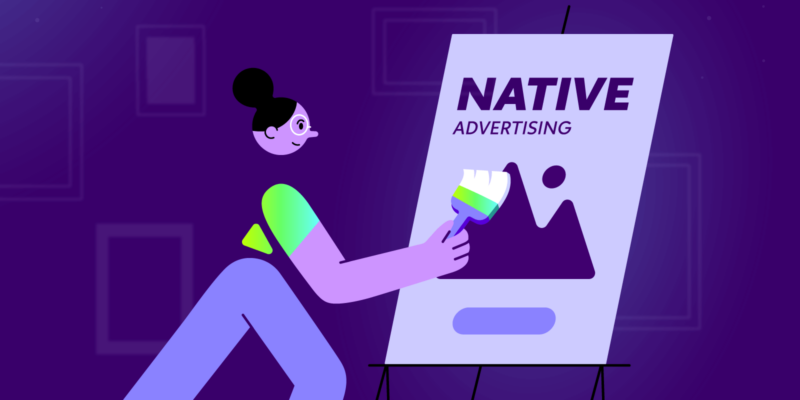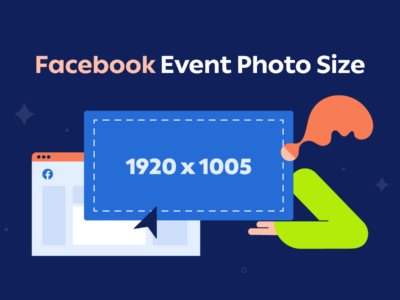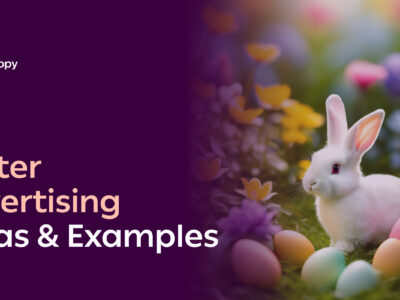In today’s digital landscape, consumers are bombarded with advertisements. Traditional ads are often ignored or even blocked, making it more challenging for marketers to reach their target audience.
This is where native advertising comes in, a strategy that has taken the marketing world by storm and is quickly becoming one of the most effective methods of reaching target audiences. According to Outbrain, native ads are 27% more trusted than social ads and 62% easier to understand than display ads, therefore offering a more engaging and efficient method compared to some traditional forms of digital advertising.
In this guide, we will clear up the concept of native advertising, discuss its benefits and challenges, and provide tips on employing it to drive success for your business.
Ready to add a new layer to your content marketing strategy?
A. What Is Native Advertising?
B. Types of Native Advertising
C. Differences Between Native Advertising and Traditional Advertising
D. Benefits of Native Advertising for Marketers
E. Best Practices for Creating Effective Native Advertisements
F. Challenges and Considerations for Native Advertising
A. What Is Native Advertising?
Native advertising definition
Native advertising is a form of paid advertising presented as organic. Just like traditional display ads, native ads are hosted on other websites (referred to as publishers) and displayed in formats that match the surrounding content.
In other words, it is the integration of ads into the natural form and function of the platform it’s being displayed on.
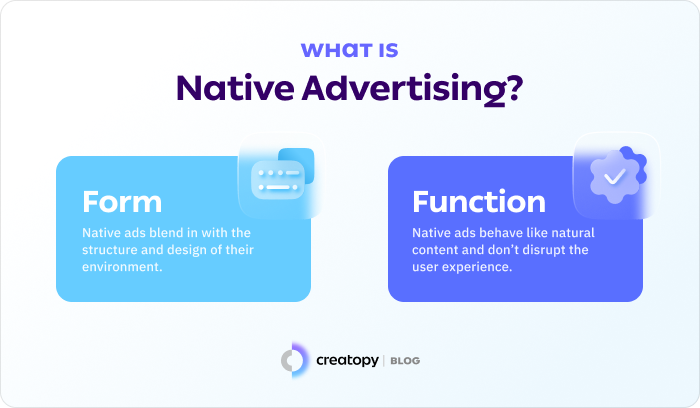
The importance of native advertising in marketing
The native approach is less intrusive and more appealing to the audience, providing a better user experience, increased engagement, and higher click-through rates than traditional display advertising.
It can also improve brand recognition and provide better ad placement, making the native approach more compelling than simple banner ads. Consequently, native marketing is also often more cost-effective–music to the ears of marketers looking to maximize their ROI.
Characteristics of native advertising
Part of native advertising’s appeal is that it doesn’t fit into cookie-cutter molds. Still, the wide range of native content formats do have a few things in common:
1. They’re not interruptive
If the purpose is to provide a smooth browsing experience, the ads can’t be too obvious. However, the point is not to deceive–on the contrary. A good native ad balances promoting your brand with providing valuable information.
2. They’re adaptable
You’re targeting your audience on platforms they already enjoy browsing. To keep it that way and make them read on, native ads blend in perfectly on any platform without trying too hard to be clever or catchy.
3. They bypass ad blindness
To avoid distractions, our brains tend to ignore ads that follow an easily recognizable pattern–call it a very effective natural ad-blocker. Native ads bypass this resistance, allowing you to build brand awareness as a fair tradeoff where viewers take away enough valuable information to make it worth their while.
How do you spot native advertising?
As a marketer, it’s important to know how to spot native advertising so that you can see what your competitors are up to. It can be a challenge at first, but the industry-wide requirements that prevent marketers from deceiving customers can help you spot native ads with ease:
A label saying ‘sponsored’ or ‘promoted’ always accompanies the ads to indicate that they are paid content;
The ads often match the look and feel of the platform they appear on, whether it’s a social media post, a blog post, or a news article, but they clearly promote a product or service;
The content often resembles the content that the platform’s users typically engage with, such as articles or videos;
They often have calls-to-action that encourage users to visit a website or download an app;
The ads are often placed within the content feed of a platform, rather than in a separate ad section.
B. Types of Native Advertising
In marketing, there’s always more than one way to crack an egg, but native advertising is particularly fertile soil for creativity. Here are some of the most popular native ad formats:

1. Sponsored content
Perhaps the format that’s most commonly associated with native advertising, sponsored posts involve creating content by an advertiser and integrating it into the publisher’s own content.
This can take the form of articles, blog posts, opinion pieces, videos, podcasts, infographics, or anything else that resembles the platform’s editorial content.
These pieces are often produced by the advertiser’s own marketing team or a third-party agency. Marketers often refer to sponsored content as ‘advertorials,’ combining the words ‘advertisement’ and ‘editorial.’

2. In-feed ads
As the name suggests, in-feed ads appear in a user’s feed, be it in their social media accounts or their news feed. They’re meant to be less aggressive and more engaging than a traditional paid ad.
In-feed ads are typically placed between standalone pieces within a content feed, which makes them ideal for mobile devices with smaller screen spaces.
You can easily customize ads to match the look and feel of any website’s content, using high-quality visual elements.
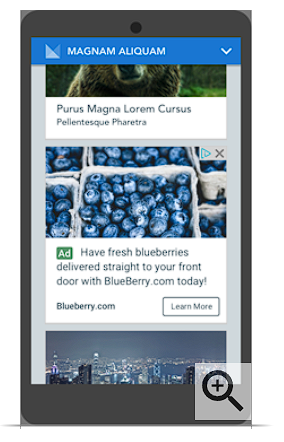
3. Paid-search ads
Search engines integrate paid ads into search result pages (SERPs) in a similar fashion to organic results.
To what extent they fit the definition is debatable, but they do blend in with organic results and do respond to user intent. They’re also clearly marked with a ‘sponsored’ or ‘ad’ icon–the same as other sponsored native content.
Unlike traditional banners, these ads are triggered by specific keywords, and advertisers only pay when someone clicks on them, making search ads an effective and efficient way to reach audiences and drive traffic.
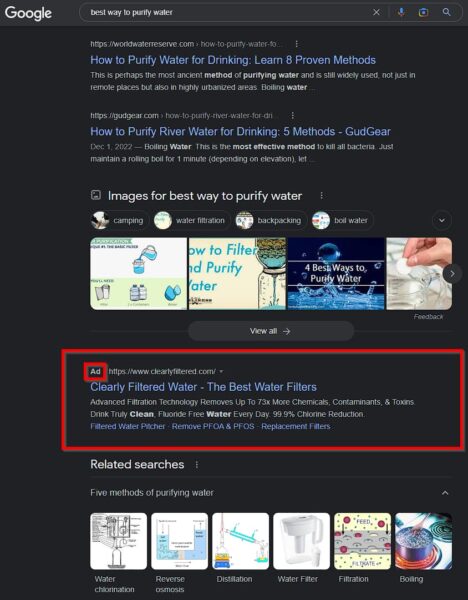
4. Recommendation widgets
Recommendation widgets appear on a website alongside its normal content and recommend products or link to relevant sponsored content, improving your audience’s online experience.
Recommendation widgets are particularly suitable for remarketing and retargeting campaigns, where you advertise to audiences that have already interacted with your brand, allowing for more compelling messaging and more efficient upselling.
Widgets collect data about visitors and use it to optimize suggestions. The system continually improves itself until it provides the most accurate and relevant recommendations to the users.
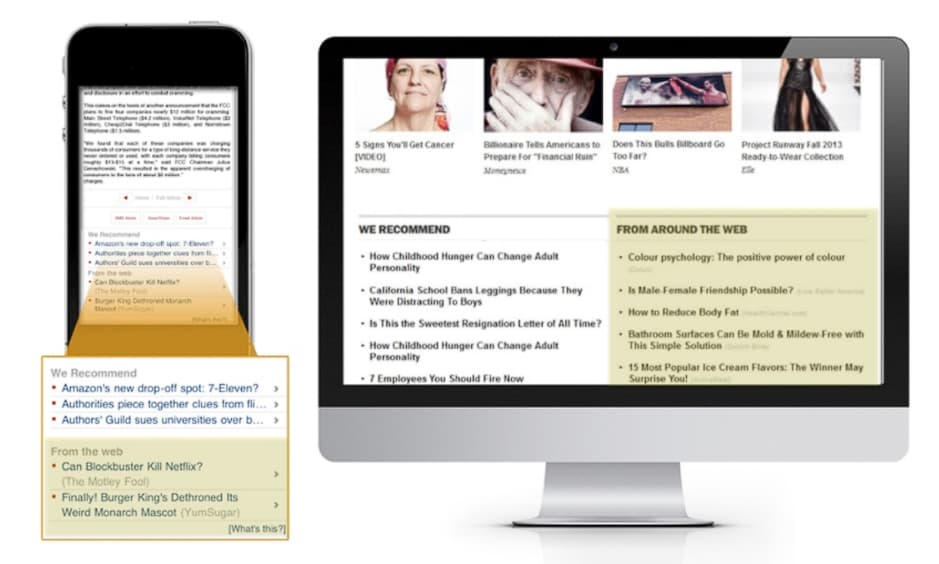
Source:Sharethrough
5. Promoted listings
Similar to how brick-and-mortar retailers provide preferential placement for high-bidding brands, ecommerce sites, travel agencies, and other listing services offer premium placement for vendors.
Promoted listings are an effective marketing strategy as they pin your listing to the top of search pages your audience is browsing–likely with a high buying intent.
This type of native advertising is often seen on e-commerce websites like Amazon and Etsy, and it’s particularly effective in combination with recommendation widgets.
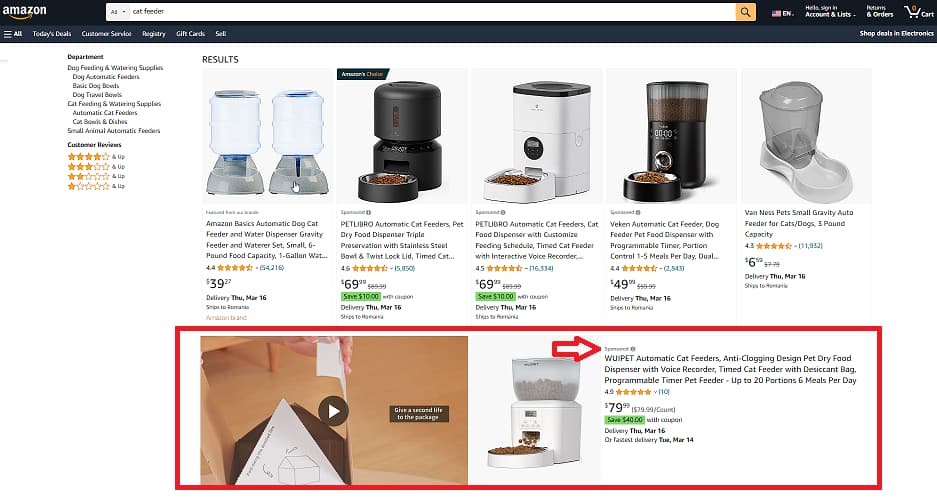
6. Native ad units
Also known as in-ad units or native display ads,
Like classic display ads, these ingeniously crafted ads are essentially simple placeholders sold to advertisers–the difference is how they’re configured. When done right, in-ad units integrate perfectly into their surroundings without looking spammy. They can also contain contextually relevant content for that extra touch of personalization.

C. Differences Between Native Advertising and Traditional Advertising
Native is gaining enormous popularity, but this is not to say traditional ads are a thing of the past. Understanding the key differences is important in order to always make the best decisions about which strategies to employ. Let’s delve deeper into these distinctions:
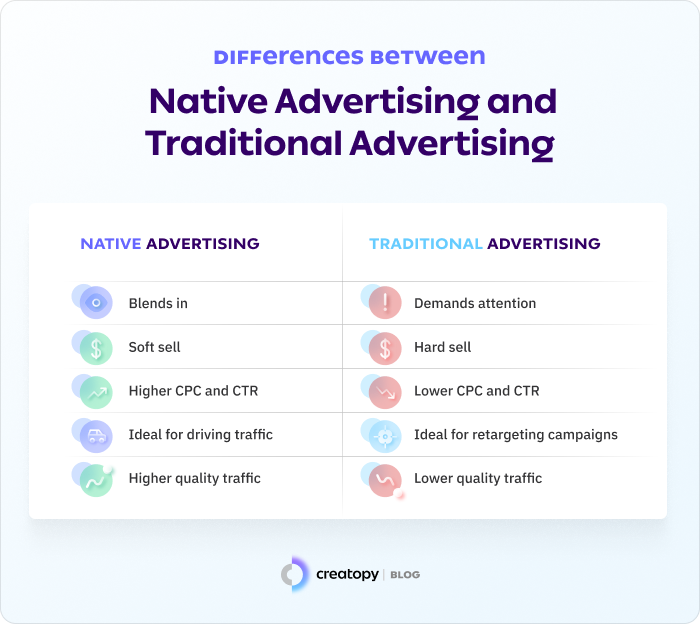
Native advertising
- Blends in. The ad is non-interruptive as it’s presented in the same style and format as any other piece of content on the site. When implemented well, it adds to the user experience rather than interfering with it.
- Soft sell. The pitch is subtle, designed for more engagement and less disruption. Thus, it’s more suitable for long-term strategies like educating your audience about your products and services.
- Higher CPC and CTR. Although native advertising has a higher cost per click, it is more cost-efficient due to its higher click-through rate.]
- Ideal for driving traffic. The ads are effective for improving brand affinity, but they shine their brightest when it comes to boosting engagement.
- Higher quality traffic. The personalized nature of the ads ensures higher-quality traffic that is more interested in your product by the time they land on your site. Granted, this also has to do with being more selective when choosing publishers for native ads.
Traditional advertising
- Demands attention. Static banners, animated images and pop-up video ads are effective at capturing attention. Then again, they need to be as they’re competing for it with the actual content users came for in the first place.
- Hard sell. The arguments are direct and insistent, designed to convert quickly. The impact has a limited ‘shelf life’. Once the ad has been displayed, it should ideally bring in a conversion within a short time.
- Lower CPC and CTR. Because they’re less relevant and often fall victim to ad blindness, display ads normally have a lower CTR.
- Ideal for retargeting campaigns. Display campaigns are good for brand awareness but they perform best further down the funnel. They’re great for reattracting high-intent visitors.
- Lower quality traffic. Ads that are less tailored to a specific publisher are more versatile, allowing marketers to open the funnel much wider. There’s always a tradeoff, though, and in this case, it’s sacrificing quality for quantity.
Native advertising vs. content marketing
Given the wide range of native ad applications, there is some degree of confusion as to how native fits into the wider concept of content marketing.
Content marketing uses high-quality content, displayed mainly on the advertiser’s own platforms, aimed to build trust and a follower base while boosting organic visibility. Native is essentially a content marketing tactic, but with paid content presented as organic content, hosted on third-party platforms.
Both are strategies to promote products and services without appearing as traditional online advertising. From a high-level perspective, the key difference is in placement and distribution.
D. Benefits of Native Advertising for Marketers
Native strategies are increasingly popular among marketers for many reasons. Let’s have a look at some of the main ones:
1. Increased engagement and click-through rates
The very fact that it blends in with the platform’s natural content lends native advertising one of its most significant benefits. Since it’s less intrusive and more relevant to the audience than traditional forms of advertising, it creates a smoother user experience, which can lead to higher engagement and click-through rates.
According to paved.com, native ads have a 0.2% average CTR compared to the 0.05% average of display ads, making for a four times higher impact.
2. Better user experience and brand recognition
More relevant content equals higher user satisfaction–most of what we call content marketing is based on this simple principle, and native advertising is basically taking the same concept and adapting it to paid ads. Truly useful content increases the chances of user engagement, helping build brand recognition in the process.
Native strategies can help establish your brand as an authority in the field and leave a lasting impression in your audiences.
3. Integration with editorial content
Native advertising is often integrated with editorial content, which provides brands with the opportunity to tell their story in a way that is aligned with the platform’s natural content. This integration can create a more compelling and trustworthy narrative for the brand, which can help to build brand credibility and authority.
Integrating native ads with editorial content can provide a better overall user experience, as it allows the audience to see the brand’s story in context. This is beneficial for both the advertiser and the publisher.
4. Cost-effectiveness compared to traditional advertising
With more premium publishers being targeted and the added expense of more personalized, longer-format copy, the overall cost of a native ad campaign tends to be higher. However, the increased engagement and click-through rates generated by native advertising can help to improve the overall cost-effectiveness.
Despite the larger investment, the better ROI makes native advertising an attractive long-term option for brands with limited advertising budgets.
How much does native advertising cost?
The cost of a native advertising campaign is complex with many variables, but it’s greatly determined by the publisher’s profile and authority, audiences, and the level of competition for traffic. Plus, the chosen format also varies in complexity, so production costs also vary on a wide scale. According to the latest public data from revenue optimization platform AdPushup, CPM for native campaigns can reach as high as $10 or even $20 whereas it’s typically in the $0.5 – $4 range for display campaigns.
Native ads cost more than display ads due to their high-quality content and targeted distribution, but their effectiveness can justify the higher cost for advertisers seeking more engaging and relevant ways to reach their audience.
E. Best Practices for Creating Effective Native Advertisements
Employing native strategies is a powerful way to connect with your target audience. To ensure the success of your campaigns, there are a few best practices you should keep in mind:
1. Understanding your target audience
Before you launch your first native ad campaign, it’s essential to understand your target audience and their needs, wants, and pain points. This information will help you create content that resonates with them and drives engagement.
You can use your existing buyer personas to help guide your advertising strategy. If you don’t have them yet, conduct extensive market research with surveys and focus groups to gather information about your target audience.
2. Creating high-quality, relevant content
The importance of high-quality, relevant content that provides value to the reader can’t be underestimated. The key to creating effective native advertisements is to align your content with the overall tone and style of the publisher’s content and provide a seamless user experience.
When creating content, use strong headlines, engaging visuals, and clear calls-to-action keeping your target audience in mind. The challenge is finding the sweet spot where your content stands out without creating a stark contrast with the existing style of the hosting platform.
3. Choosing the right format and platform
As discussed above, native advertising can come in many different shapes and sizes. Each format has its pros and cons, but your goals and target audience that will have the last say in which is the right one for your brand.
Apart from your demographics, consider your budget and the type of content you want to create when choosing a format. Once you have a preferred format, select the best-fitting platform. High-authority news websites may be the first to come to mind, but depending on your audience native ads can also be very effective on social media and multimedia streaming.
4. Measuring success and optimizing performance
Just as with traditional campaigns, sustainable success starts way before launching the ads. Setting clear goals and tracking the right metrics from the get-go will help keep your eyes on the ball and make the right decisions further on.
As a general rule, keep an eye on engagement rates, click-through rates, and conversions. Use these metrics to measure the performance of your campaign and make data-driven decisions to optimize your strategy. Regularly analyze your results and make changes to your strategy as needed to improve performance.
Pro tip: Diversify your strategy and use native formats where they work best
Long-form ads work great in the awareness phase, so you can use, for instance, sponsored posts to get your audience to know your product. This can be evergreen content ensuring long-term exposure.
You can use native ads as a gateway to your own blog where you can answer further questions, elegantly leading your audience through the consideration phase.
The lion’s share of the work is done at this point–all you need to do is retarget your audience with a lower-cost display ad campaign to really hammer in your value proposition and complete the conversion.
F. Challenges and Considerations for Native Advertising
No powerful tool is without dangers, and native campaigns have their own pitfalls and challenges too. Pay special attention to the following aspects:
1. Balancing the interests of advertisers and publishers
The main challenge in native advertising is finding the balance between your goals and the interests of your publishers. You obviously want to stand out and drive conversions, but your publishers will want to maintain the integrity of their content and ensure your ads don’t detract from the user experience.
To overcome this, work closely with the publisher to create content that aligns with their tone and style. It’s helpful to approach native campaigns with the same attitude that’s proven to work in traditional content marketing: the result should provide value to the audience. If it’s not worth their time, it’s probably not worth your time either.
2. Maintaining transparency and avoiding deceptive practices
Native strategies blur the line between editorial content and ads by definition. This puts advertisers on thin ice, so it’s key to maintain transparency. It’s flawed to think that native works in the subconscious–on the contrary. Your audience must be fully aware they’re seeing an ad. It’s just that they don’t mind because they get something in return.
Always make sure your ads are labeled as such, and explain the purpose of the advertisement clearly. Misleading headlines (or worse, fake news) are not unheard of in online marketing, but they’re never worth it. They harm the brand’s reputation irreparably and erode trust with your audience.
3. Staying compliant with legal and ethical standards
Native advertising is subject to laws and regulations to ensure ethical and legal compliance. Advertisers must follow standards specific to each platform and region, such as content restrictions and data privacy laws like GDPR (General Data Protection Regulation) in Europe and CCPA (California Consumer Privacy Act) in the U.S. The FTC (Federal Trade Commission) also requires clear labeling and prohibits misleading or deceptive content.
Failure to comply with these standards can result in penalties, making it crucial to stay up-to-date and transparent with data collection and usage practices.
4. Measuring ROI and proving the effectiveness of native advertising
In order to track your KPIs correctly you should know your objectives and understand how you want to achieve them. If you aim to build brand awareness, you should focus on reach metrics like impressions and unique visitors as well as behavior metrics such as bounce rate and average session duration. If it is leads you’re after, track downloads and conversion rates.
Once your native campaign has been launched, you can use a combination of analytics tools and A/B testing to measure the impact of your native ads and make optimizations as needed.
Conclusion
Native advertising is a powerful tool for marketers. With the right strategy, it opens a channel to engage with their target audience in a more meaningful and relevant way.
Recap of the benefits and challenges of native advertising
Native advertising offers a number of benefits to marketers, including increased engagement, better user experience, and higher conversion rates compared to traditional advertising.
However, there are also a number of challenges that advertisers must be aware of, including maintaining transparency and avoiding deceptive practices, staying compliant with legal and ethical standards, and measuring ROI.
Final thoughts and recommendations for marketers
To harness the full power of native advertising, the best practices are understanding your target audience, creating high-quality and relevant content, choosing the right format and platform, and measuring the success of your campaigns in order to make optimizations and improvements.
It’s also important to stay up-to-date on the latest developments in the world of native marketing, including changes in regulations, emerging technologies, and best practices. This will help your brand stay ahead of the curve and take full advantage of the native ad opportunities that come your way.
What does the future hold for native advertising?
It’s anyone’s guess what the next big thing will be in online marketing, but native strategies are certainly here to stay for many years to come. The global value of the native advertising market is estimated at around $100B and it’s projected to exceed $650B by 2032.
As technology and consumer behaviors evolve, so too will the opportunities to place native content across the web. The challenge for the future is simply to stay informed and adapt to the changes–all it takes is a little conscious effort to stay on top of the latest trends.

